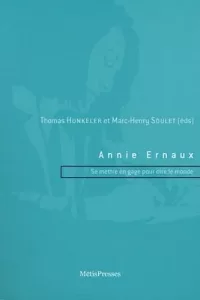The conference ‘Annie Ernaux. Se mettre en gage pour dire le monde’ (‘Annie Ernaux: putting herself on the line to write the world’) took place in May 2010 at the University of Fribourg, Switzerland, in Ernaux’s presence. It led to the publication of the collective volume Annie Ernaux. Se mettre en gage pour dire le monde, edited by the conference organisers, Thomas Hunkeler & Marc-Henry Soulet (MétisPresses, Collection Voltiges, 2012).
Thomas Hunkeler answered our questions about the conference and Ernaux’s place in the contemporary literary field:
1. What were your objectives in organising the conference in Fribourg in 2010?
The conference took place on 21-22 May at the University of Fribourg. We saw it as the culmination of a series of public interdisciplinary seminars that Marc-Henry Soulet (in the Sociology department) and I (in French literature) taught together. In that context, we were able to welcome Annie Ernaux for an interview, on the evening of 21st May. At the time, our objectives were twofold: firstly, we wanted to move across interdisciplinary fields in order to revive encounters between the different social sciences within a large faculty of letters; secondly, it was the opportunity to give free rein to the collective analysis of a literary corpus which we were both passionate about. Thoughout the semester, we had been studying and analysing the works of Annie Ernaux in turn, at the junction between sociology and literature, in order to better understand how her writing ‘put itself on the line’, as we said then. Then, the conference was the opportunity to open up to other critical voices, in order to approach the inexhaustible wealth of Ernaux’s texts.

2. In your opinion, what role does Ernaux play in the contemporary literary field?
At the time, Les Années [The Years] had only recently been published. This is a major text, the culmination of her writing, the significance of which will be lasting for many years to come. But since Les Années, Annie Ernaux has kept writing and publishing; she has also expressed her opinions publicly. At the time, she was already very well-known, but now, she has undoubtedly become a monument in French literature, even if she would probably hate this image, which sounds emphatic and stiff. Let’s rather say that her works have become a point of reference, a corpus which acts as landmark. What I find most poignant, is that her works keep on appealing to younger generations – maybe not so much through the experiences she portrays but through her resolute honesty.
3. Since that conference took place, which publications by Annie Ernaux do you view as particularly significant?
All of her writings are obviously significant, both in relation to the creation of a literary corpus but also through the questions that they put forward. But also insofar as her new publications often throw light on her other texts; they express things that had been kept silent, scars that run deep, and stylistic choices. If we take the example of Mémoire de fille [A Girl’s Story], this book sheds new light on her very first novels, Les Armoires vides or Ce qu’ils disent ou rien. Like all avid readers of Annie Ernaux’s works, we keep an eager eye, every year, on new publications by Gallimard, hoping to discover the publication of a new book, which will undoubtedly find a new way to surprise us.
[translation into English: Elise Hugueny-Léger & Lyn Thomas]
